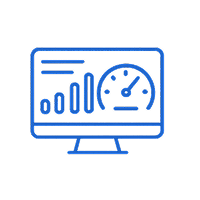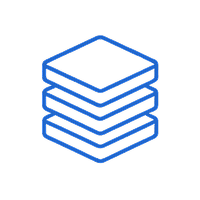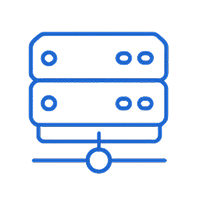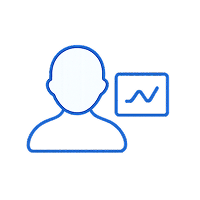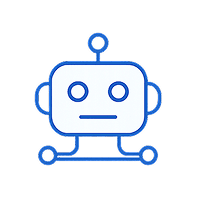Datadog offers one of the most comprehensive observability ecosystems, with polished dashboards, hundreds of integrations, and strong APM and infrastructure monitoring out of the box. However, many teams struggle with its high and unpredictable costs as data volume grows.
CubeAPM is the most compelling alternative to Datadog as it offers a full-stack, OpenTelemetry-native observability platform built for teams who demand predictable and affordable pricing even at scale. With no per-user fees and ingestion of $0.15/GB, CubeAPM offers up to 80% cost savings over Datadog.
In this article, we’ll break down the top Datadog alternatives in 2025 across categories like feature depth, deployment flexibility, pricing transparency, OTEL compatibility, and support experience, starting with CubeAPM.
Top 7 Datadog Alternatives
- CubeAPM
- Coralogix
- Grafana
- Dynatrace
- New Relic
- Sentry
- Splunk AppDynamics
APM Tools Comparison: Datadog vs CubeAPM vs Others (2025)
| Tool | *Pricing (Small, Mid, Large Teams) | OTEL Native | Support TAT | Deployment Option |
| CubeAPM | Small: $2,080 Mid: $7,200 Large: $15,200 | Yes | Within minutes | Self-hosted |
| Datadog | Small: $8,185 Mid: $27,475 Large: $59,050 | *No | <2hrs-48hrs | SaaS only |
| Dynatrace | Small: $7,740 Mid: $21,850 Large: $46,000 | *No | 4hrs to days | SaaS and Self-hosted |
| Splunk AppDynamics | Small: $2,650 Mid: $9,825 Large: $20,150 | *No | 2hrs to days | SaaS and Self-hosted |
| Grafana | Small: $3,870 Mid: $11,875 Large: $26,750 | Yes | 2hrs to 6hrs | SaaS and Self-hosted |
| Coralogix | Small: $4,090 Mid: $13,200 Large: $29,000 | Yes | Within minutes | SaaS only |
| Sentry | Small: $3,560 Mid: $12,100 Large: $32,400 | *No | hrs to days | SaaS and Self-hosted |
| New Relic | Small: $7,896 Mid: $25,990 Large: $57,970 | *No | 2hrs to days | SaaS only |
*All pricing comparisons are calculated using standardized Small/Medium/Large team profiles defined in our internal benchmarking sheet, based on fixed log, metrics, trace, and retention assumptions. Actual pricing may vary by usage, region, and plan structure. Please confirm current pricing with each vendor.
*OTEL Sources: Datadog uses proprietary SDKs; Dynatrace uses collectors; Splunk AppDynamics uses collectors
Why Look for Datadog Alternatives?
Although Datadog delivers rich features across the MELT stack, its growing adoption has also surfaced several critical drawbacks that engineering and platform teams increasingly report:
1. Fragmented and Explosive Pricing
Datadog charges for nearly every aspect of observability: hosts, logs, traces, synthetics, data transfer, and user seats. Teams with even modest scale face high monthly costs. For example:
- Starting at $35/host/month for APM Pro
- Logs: $0.1/ingested GB
- Infra Cost: starting at $15/host/month for Pro Plan
Datadog’s pricing structure, while modular, becomes increasingly difficult to predict as teams scale. Charges are incurred per host, and per telemetry type—making it easy to underestimate total costs.
*The volume of data ingested and team sizes are from our standardized internal benchmarking sheet.
Datadog Cost for Mid-Sized Team
APM Hosts: $4,375 (125 x $35)
Profiled Hosts: $1,600 (40 x $40)
Profiled Container Hosts: $200 (100 x $20)
Indexed Spans: $850 (500,000,000 x1.70/1000000)
Infra Hosts: $3,000 (200 x $15)
Container Hours: $3,000 (1,500,000 x $0.002)
Custom Metrics: $3,000 (300,000 x $0.01)
Ingested logs (live and rehydrated in GB): $1,000 (10,000 x $0.1)
Indexed logs (Million log events): $5,950 (3500 x $1.70)
Observability data out cost (charged by cloud provider): $4,500 (45,000 x $0.1)
Total: $27,475
CubeAPM Cost for a Mid-Sized Team
Total Monthly data ingestion (GB): $6,750 (45,000 x 0.15)
Observability data out cost (charged by cloud provider): $450 (13,000 x $0.01)
Total: $7,200
This pricing clarity and scalability make CubeAPM a compelling alternative for engineering teams seeking predictable observability without financial sprawl.
2. Limited Native OpenTelemetry Support
While Datadog is not OTEL native. Data often needs to be transformed or routed via Datadog collectors to fully function, leading to lock-in and unnecessary complexity. This also makes it harder to migrate or integrate other tools that use standard OTEL pipelines.
3. Steep learning curve and complexity for setup and usage
Users highlight that setting up dashboards, tuning alert rules, building monitors, navigating between products, and optimizing usage takes considerable time and expertise. While Datadog provides extensive capabilities, many teams find the UI dense and the configuration steps overwhelming—especially when setting up multi-service tracing, infrastructure maps, or custom metrics dashboards.
4. Overwhelming UI / feature overload for smaller teams
Some users describe it as “feature overload” — powerful but cluttered, with too many screens and configuration layers.
Teams that only need core APM + logs often feel Datadog is “more than they need,” and end up paying for or navigating features they don’t fully use. This complexity pushes some companies to consider more focused or easier-to-use observability platforms.
Criteria for Suggesting Datadog Alternatives

Image Source: Reddit
To identify the most viable replacements for Datadog, we evaluated platforms across these critical dimensions:
1. OpenTelemetry-Native Ingestion
We prioritized platforms that natively integrate OTEL without needing proprietary wrappers. This ensures easy migration, future-proof instrumentation, and flexibility to build your own observability pipeline. Tools like CubeAPM, Coralogix, and Grafana stand out here.
2. Unified MELT Stack Coverage
Full-stack observability means capturing Metrics, Events, Logs, and Traces, ideally enriched with RUM, synthetics, and error tracking. We favored platforms that offer native support without needing bolt-on integrations or third-party tools.
3. Transparent Pricing Model
We avoided tools with hidden pricing tiers or nickel-and-dime billing. CubeAPM charges a simple $0.15/GB flat rate, with no user or host fees, enabling predictable and scalable observability.
4. Support Experience & Developer Friendliness
We looked for tools that offer fast, human support—ideally over Slack or chat—plus intuitive dashboards and fast setup. CubeAPM offers 1-hour onboarding, direct Slack access to engineers, and dashboards that “just work.”
1. Datadog Overview

Known For
Full-stack observability for cloud-native environments. Datadog is one of the most widely adopted SaaS observability platforms, known for its breadth across infrastructure monitoring, application performance monitoring (APM), log analytics, and security monitoring. It’s a go-to solution for teams that want an all-in-one monitoring platform tightly integrated with cloud services like AWS, Azure, and GCP.
Standout Features
- Deep cloud-native integrations (e.g., AWS Lambda, ECS, Kubernetes)
- Extensive plugin ecosystem (900+ integrations)
- Real-time dashboards with drag-and-drop UI
- Security monitoring alongside observability
- Machine learning–powered anomaly detection
Key Features
- APM & Distributed Tracing: End-to-end tracing across services, with service maps and flame graphs.
- Infrastructure Monitoring: Visualize metrics from VMs, containers, and cloud-native infra.
- Log Management: Collect, filter, and analyze logs with full-text search and alerting.
- Real User Monitoring (RUM): Track frontend performance from the user’s perspective.
- Synthetic Monitoring: Automated uptime and API checks (HTTP, browser-based).
- Security Monitoring: Detect and respond to security threats using runtime telemetry.
Pros
- Strong UI/UX and customizable dashboards
- Unified view across APM, infra, logs, synthetics, and RUM
- Massive third-party integration support
- Mature documentation and developer resources
- Active ecosystem with regular feature releases
Cons
- Costs rise quickly as systems scale
- Hard to learn and time-consuming to configure
- The interface can feel overwhelming
Best For
- Enterprises with large budgets that value convenience and UI polish over cost
- Teams already heavily invested in AWS, Azure, or GCP and want pre-built integrations
- Organizations prioritizing breadth of observability features in a single dashboard
Pricing & Customer Reviews
- Infrastructure Monitoring (Pro Plan): $15/host/month
- APM (Pro Plan): $35/host/month
- Logs: $0.10/per ingested GB/month
- G2 Rating: 4.4 / 5
- Praised for: UI simplicity, integrations, dashboards
- Criticized for: Poor pricing transparency, steep learning curve, overwhelming UI
Top 7 Datadog Alternatives
1. CubeAPM Overview

Known For
CubeAPM is a modern, developer-focused APM platform built to deliver real-time observability across applications and infrastructure with smart local processing, not dependent on third-party data pipelines. It enables 2–4x faster page loads compared to cloud-heavy APMs by ingesting and analyzing telemetry data—traces, metrics, and logs—within your own infrastructure.
Key Features
- Application Performance Monitoring (APM): Deep visibility into service performance with distributed tracing, latency analysis, and bottleneck identification. Native support for OpenTelemetry and compatibility with Datadog/New Relic agents makes migration easy.
- Smart Sampling: CubeAPM’s Smart Sampling prioritizes high-value traces (errors, latency spikes) over normal events using contextual data—reducing ingestion volume and cost by up to 60%.
- Log, Infra, and Error Monitoring: Supports full-stack observability: logs, infrastructure metrics, and error tracking—all in one UI. No additional modules or licenses required.
- Real User & Synthetic Monitoring: Built-in support for RUM and synthetics (API/browser checks) at no additional charge, with unlimited usage tiers.
Standout Features
- Smart sampling
- Full-stack observability out-of-the-box
- Real-time Slack/WhatsApp support from core devs
- Self-hosted setup in <1 hour
- Compatible with Datadog, New Relic, Prometheus, and OTEL
Pros
- 60–80% cost savings vs. incumbents like Datadog
- Native OpenTelemetry support for seamless migration
- Unlimited retention and full MELT stack in one tool
- Fast, developer-friendly support experience
- Data residency compliance with zero egress costs
Cons
- Not suited for teams looking for off-prem solutions
- Strictly an observability platform and does not support cloud security management
Best For
- Engineering orgs seeking lower cost and control over telemetry
- Startups and mid-sized teams scaling fast but watching budgets
Pricing & Customer Reviews
- Pricing: Ingestion-based pricing of $0.15/GB
- Rating: 4.7 / 5 (based on pilot programs, Slack feedback, and demos)
- Common praise: Fast support, cost efficiency, sampling quality
- Common critique: Limited prebuilt dashboards (work in progress)
CubeAPM vs Datadog
While Datadog charges separately for APM, logs, synthetics, and infra, CubeAPM offers flat pricing with no hidden fees, retaining high-value telemetry through Smart Sampling. CubeAPM is ideal for teams who want cost efficiency and control, without sacrificing core observability capabilities.
2. Coralogix Overview
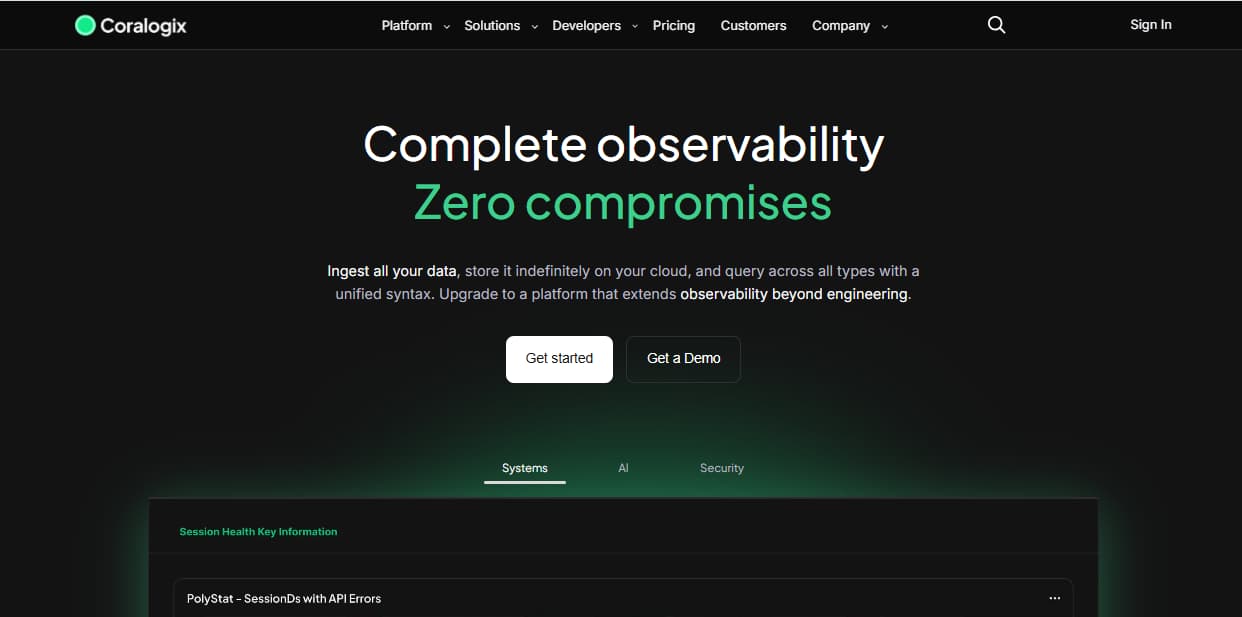
Known For
Full-stack observability platform with Streama™ architecture, strong ingestion control, and log-first observability workflows. It is built for advanced stream processing, customizable ingestion pipelines, and native OpenTelemetry support. Ideal for teams that prioritize deep log analytics, pipeline flexibility, and cost-efficient routing.
Key Features
- Streama™ Architecture: Coralogix is built around structured logging, indexing policies, and dynamic routing. It uses a unique Streama™ pipeline to process logs in real-time before storage, allowing tiered routing for active, warm, and archived logs.
- Archive Storage in Customer Cloud: Archived logs are offloaded to your cloud storage (e.g., S3 or GCS), minimizing long-term storage fees. However, data first flows through Coralogix servers, triggering public egress costs and compliance risks for regulated environments.
- Query-While-Archived: Ability to query archived logs directly from customer buckets—without full rehydration—offering better control over retrieval costs.
Standout Features
- Streama™ engine for real-time parsing and routing
- Custom indexing rules per log type
- Ingest once, route to multiple destinations
- Supports cloud-native archive integration (S3, GCS)
Pros
- Fine-grained control over log retention and cost
- Streama™ gives flexibility in log processing and routing
- Strong performance for log-heavy use cases
- Archived logs cost far less than SaaS storage
- OTEL and Prometheus-compatible ingestion
Cons
- Steep learning curve for advanced features
- Costs can spike as data volume grows
- Interface can feel unintuitive at times
- Occasional missing integrations or capabilities
Best For
- Teams with heavy log ingestion workloads
- Companies focused on log analysis and routing control
- Use cases where cold storage or archival compliance is a priority
- Ops teams needing real-time pipeline control
Pricing & Customer Reviews
- Logs: $0.42/GB
- Traces: $0.16/GB
- Metrics: $0.05/GB
- AI: $1.5/1M tokens
- G2 Rating: 4.5 / 5
- Praised for: Log routing control, S3 storage integration, flexibility
- Criticized for: Complex setup, steep learning curve, and overwhelming UI
Coralogix vs Datadog
Datadog offers a broad, mature observability platform with extensive integrations, polished dashboards, and automated APM/tracing workflows, making it strong for teams that want out-of-the-box visibility. Coralogix also supports full MELT ingestion but focuses on real-time stream processing and flexible data routing, which helps reduce indexing and storage costs. However, Datadog generally provides deeper ecosystem coverage and smoother automation, while Coralogix gives teams finer control over ingestion and more predictable costs at scale compared to Datadog.
3. Grafana Overview
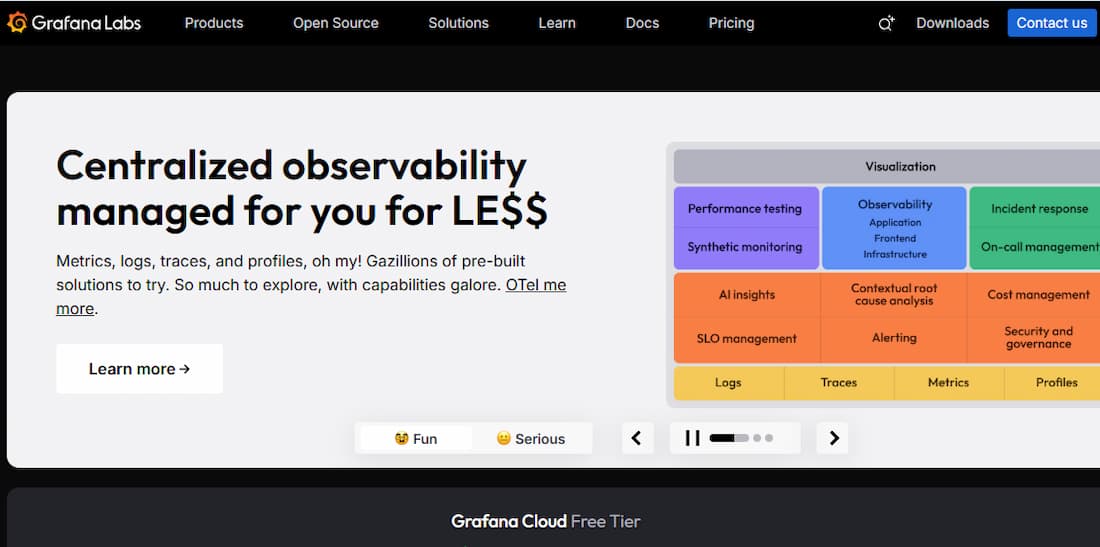
Known For
Open-source, customizable observability and visualization platform for time-series data and cloud-native metrics. Grafana is the de facto standard for visualizing infrastructure and application metrics, especially when paired with tools like Prometheus, Loki, and Tempo. It offers a modular, plugin-based observability experience that’s highly popular among DevOps and SRE teams.
Key Features
- Dashboards & Visualization: Grafana excels at customizable dashboards that visualize metrics from Prometheus, Graphite, InfluxDB, Elasticsearch, and dozens more. It supports ad hoc queries, templating, and alerting across time-series data sources.
- Grafana Loki (Logs): Grafana offers Loki for log aggregation, a horizontally scalable log backend that stores logs in compressed chunks, indexed only by labels—offering a Prometheus-like experience for logs.
- Tempo (Traces) & Mimir (Metrics): Grafana provides Tempo for distributed tracing and Mimir for metrics storage. While not deeply integrated like Datadog, the modularity allows custom OTEL-based observability stacks.
- OpenTelemetry Compatibility: Grafana integrates cleanly with OTEL through Prometheus exporters, OTLP receivers, and native support in Tempo and Loki.
Standout Features
- Fully open-source, modular observability stack
- Plug-and-play integrations with almost every popular time-series data source
- Highly customizable dashboard UX
- Works well in Kubernetes and cloud-native setups
- Strong community and open plugin ecosystem
Pros
- Free and open-source (Grafana OSS); Grafana Cloud for SaaS option
- Powerful visualization and alerting across diverse data types
- Excellent support for Prometheus, Loki, Tempo, and OTEL
- Can be self-hosted for compliance needs
- No vendor lock-in
Cons
- Steep learning curve and complex setup
- Operational overhead due to reliance on storage backends
- Users report dashboard issues, including difficult navigation
Best For
- Engineering teams comfortable with open-source stack management
- Kubernetes-native orgs using Prometheus + Loki + Tempo
- Companies needing custom dashboards and flexible deployments
- Teams with data privacy or compliance needs favoring self-hosting
Pricing & Customer Reviews:
- Grafana OSS: Free and open-source
- Grafana Cloud (SaaS): Pro: $19/month
- Advanced: $299/month
- G2 Rating: 4.5 / 5
- Praised for: Visualization power, integration ecosystem, and control
- Criticized for: Complexity in full-stack setup, hidden SaaS costs at scale
Grafana vs Datadog
Grafana offers unmatched dashboard flexibility and open-source freedom compared to Datadog’s closed platform. While Datadog provides a tightly integrated, out-of-the-box MELT experience, Grafana requires combining multiple components (Loki, Tempo, Prometheus). Grafana is ideal for teams that want control, cost flexibility, and no vendor lock-in, whereas Datadog suits teams looking for an all-in-one SaaS with less setup but higher cost.
4. Dynatrace Overview
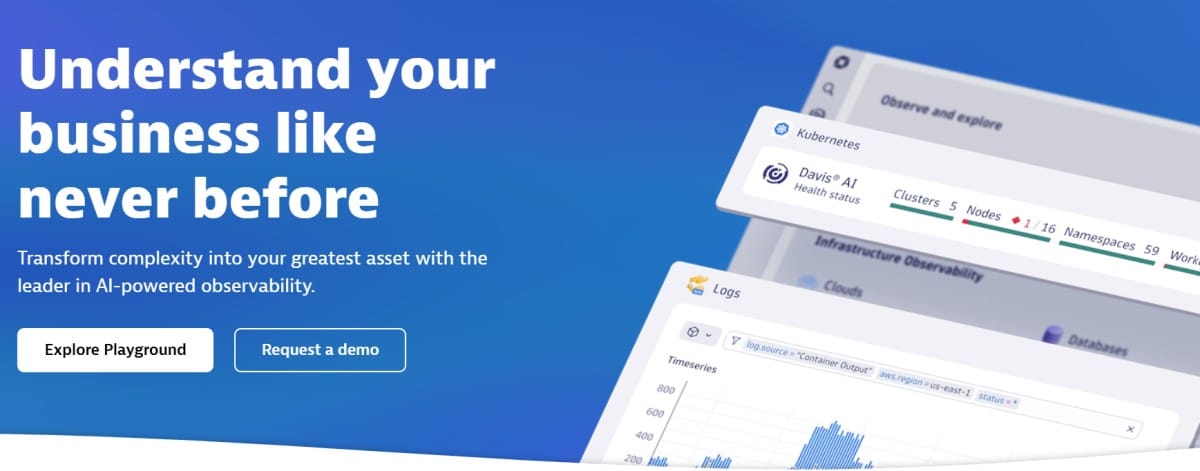
Known For
AI-powered, enterprise-grade full-stack observability with automated root cause analysis and business analytics.
Dynatrace is a premium observability platform used heavily in large enterprises for its high automation, deep cloud-native integrations, and Davis AI engine that helps proactively detect and resolve issues.
Key Features
- OneAgent Auto-Instrumentation: Dynatrace’s signature OneAgent automatically instruments infrastructure, code, and services without the need for manual setup or multiple agents. It enables real-time observability into processes, containers, and application code.
- Davis AI Engine: Dynatrace leverages Davis®, an AI engine that performs automatic anomaly detection, root cause analysis, and impact evaluation across MELT data. It’s designed to reduce alert fatigue and manual triaging.
- Cloud-Native Observability: Strong native integrations with Kubernetes, AWS, Azure, and GCP. Dynatrace can monitor workloads, pods, and services with context-aware telemetry and built-in topology maps.
- Business Analytics: Goes beyond observability by tying technical metrics to business KPIs—like revenue, conversion, and service-level objectives (SLOs)—making it useful for product and operations teams.
Standout Features
- OneAgent: Single-install, zero-config instrumentation
- Davis AI for real-time root cause analysis
- Automatic service maps and dependency topology
- Native support for OpenTelemetry ingestion
- Business-impact correlation and SLO monitoring
Pros
- Extremely detailed application insights with low setup overhead
- Davis AI dramatically reduces MTTR and manual debugging
- Scalable for massive, complex microservices environments
- Tight DevOps + BizOps alignment through business analytics
- Strong security posture with runtime application protection (RASP)
Cons
- Premium pricing — among the most expensive tools in the category
- Steep learning curve for advanced use cases and data modeling
- UI / UX can sometimes be overwhelming or non-intuitive
Best For
- Large enterprises running mission-critical workloads
- Organizations needing automated root cause detection
- Teams seeking to align engineering and business metrics
- Environments with high complexity and multiple cloud vendors
Pricing & Customer Reviews
- Full-Stack Monitoring: $58 /month/8 GiB host
- Infra Monitoring: $29/month/8 GiB host
- G2 Rating: 4.5 / 5
- Praised for: AI capabilities, automation, deep visibility
- Criticized for: Cost, overwhelming UI
Dynatrace vs Datadog
Both Dynatrace and Datadog offer full-stack observability, but Dynatrace is built for larger enterprises with AI-driven automation and business metric correlation. While Datadog offers greater modularity and broader community support, Dynatrace delivers deeper automation and out-of-the-box intelligence—but at a premium cost. For teams that need predictive insights and AI-led triaging, Dynatrace may be the stronger (if more expensive) choice.
5. New Relic Overview

Known For
Developer-focused observability platform offering a unified experience across APM, infrastructure, logs, and synthetics.
New Relic provides full-stack observability with an intuitive interface, powerful instrumentation SDKs, and a flexible query engine (NRQL). It has repositioned itself with a usage-based pricing model aimed at startups and growing teams.
Key Features
- APM & Distributed Tracing: New Relic offers deep code-level insights across multiple languages with service maps, flame graphs, and customizable trace visualizations. It helps track slow queries, external calls, and error trends in production.
- Infrastructure & Logs: Real-time metrics from VMs, containers, and Kubernetes clusters, along with log aggregation and search. Logs can be correlated with APM traces for deeper visibility into incidents.
- Synthetic & Real User Monitoring (RUM): Monitor uptime and availability using synthetic checks, and capture end-user performance via browser and mobile instrumentation.
- Custom Dashboards & NRQL: Powerful querying and dashboard capabilities using NRQL (New Relic Query Language), enabling flexible views and dynamic KPIs tailored to business needs.
Standout Features
- All-in-one observability platform under a single UI
- Extensive SDKs and agent coverage for backend and frontend
- Custom dashboards using NRQL
- Developer-friendly documentation and integrations
- Free tier available with generous limits
Pros
- Full MELT stack with strong RUM and synthetics
- Powerful visualizations and customizable query language
- Transparent usage-based pricing with a generous free tier
- Native OpenTelemetry and Prometheus support
- Solid onboarding and support ecosystem
Cons
- Cost scales rapidly with ingestion and user count
- Steep learning curve, dashboards require NRQL knowledge for full flexibility
- Complex pricing model and billing structure
- Overwhelming interface and feature overload
Best For
- Dev-first teams looking for intuitive dashboards and easy integrations
- Startups and mid-sized orgs needing full-stack visibility on a budget
- Businesses looking for usage-based billing over per-host licensing
Pricing & Customer Reviews:
- Free: 100GB/month ingested
- Data ingested: $0.40/GB beyond the free 100 GB
- Full Platform User: $418.80/user(for monthly pay as you go)
- G2 Rating: 4.4 / 5
- Praised for: Ease of use, clean UI, SDK coverage
- Criticized for: Pricing complexity, steep learning curve and complexity in setup.
New Relic vs Datadog:
New Relic and Datadog are direct competitors in full-stack observability, but New Relic stands out with NRQL-driven dashboards, a free tier, and developer-first onboarding. Datadog provides more out-of-the-box automation and prebuilt dashboards, while New Relic appeals to teams wanting query flexibility and SDK customization. Pricing for both becomes high at scale, but Datadog often incurs more modular billing surprises.
6. Splunk AppDynamics Overview
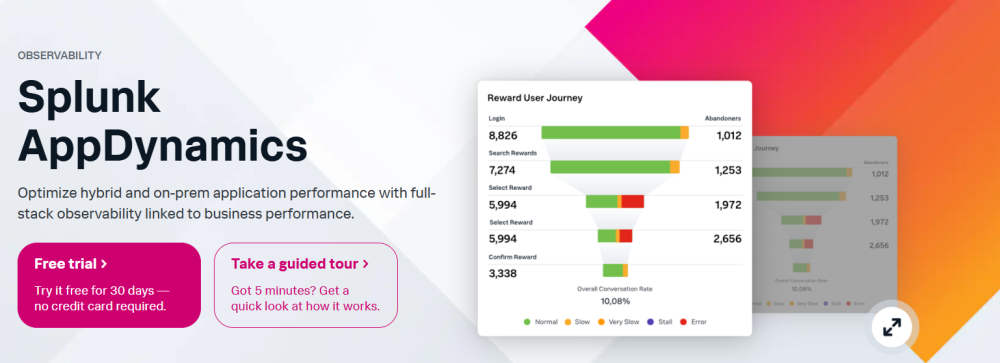
Known For
Hybrid and on-premise application performance monitoring tightly integrated with business performance insights.
Splunk AppDynamics combines deep application diagnostics with business journey mapping, targeting enterprises needing high visibility across both technical and business KPIs. It’s widely adopted in industries where performance impacts revenue directly.
Key Features
- Business Transaction Monitoring: AppDynamics captures business transactions, automatically mapping every request across services, queues, and databases. This allows engineers to monitor app flows aligned to user journeys and business logic.
- Application Performance Diagnostics: Provides detailed code-level diagnostics, including error snapshots, memory leaks, and thread activity—especially strong in Java and .NET environments. Historical baselines enable performance anomaly detection.
- Business iQ & Journey Analytics: One of the standout capabilities is Business iQ, which links telemetry to metrics like revenue conversion, drop-off rates, and transaction health across funnels (e.g., checkout, registration).
- Hybrid Cloud and On-Prem Support: AppDynamics supports hybrid workloads including on-prem deployments, making it suitable for organizations that haven’t fully transitioned to the cloud.
Standout Features
- Business iQ for customer journey and KPI analytics
- Application-centric performance mapping
- Deep diagnostics for Java, .NET, PHP, Node.js, and more
- On-premise & hybrid cloud deployment models
- Now integrated into the Splunk observability portfolio
Pros
- Ideal for transaction-heavy, revenue-sensitive applications
- Business and technical metrics under one roof
- Reliable support and enterprise-grade SLAs
- Good fit for hybrid/on-prem data models
- Long track record in Fortune 500 and financial services
Cons
- UI/UX can be overwhelming, especially for beginners
- High cost, especially at enterprise scale
- Complex and confusing pricing/licensing structure
Best For
- Enterprises with hybrid infrastructure and legacy app stacks
- Teams that must tie application behavior to business outcomes
- Regulated industries with on-prem compliance requirements
- Existing Cisco or Splunk customers integrating observability with security
Pricing & Customer Reviews
- Pricing: $75/host/month, billed annually
- G2 Rating: 4.3 / 5
- Praised for: Business visibility, diagnostics depth, and reliable support
- Criticized for: Outdated UI, licensing complexity, cost
Splunk AppDynamics vs Datadog
While Datadog delivers strong out-of-the-box full-stack observability, Splunk AppDynamics is built for enterprises that prioritize business journey analytics and hybrid/on-prem environments. AppDynamics provides deeper transaction-level tracing with better alignment to KPIs, but at the cost of greater complexity and higher pricing. Datadog, by contrast, is more agile, better for cloud-native teams, and faster to set up—but lacks AppDynamics’ business-performance lens.
7. Sentry Overview
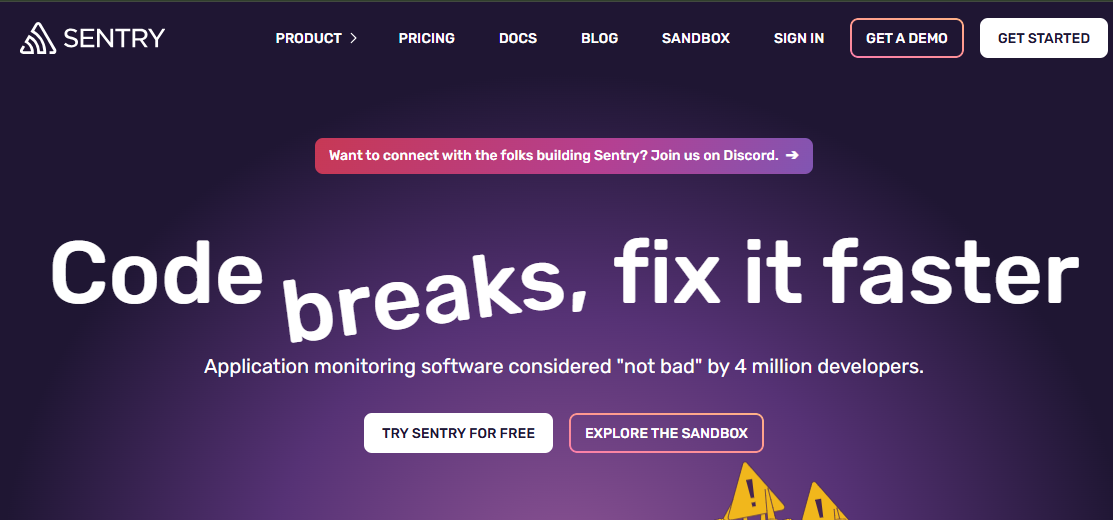
Known For
Real-time error tracking and performance monitoring tailored for frontend and backend developers.
Sentry started as an open-source error-tracking solution and evolved into a developer-friendly observability platform focused on performance, crash analytics, and release health.
Key Features
- Error Tracking & Exception Monitoring: Sentry captures detailed exception logs with stack traces, release tracking, and breadcrumb trails, helping engineers quickly debug runtime errors in production environments.
- Performance Monitoring: Lightweight distributed tracing shows latency hotspots, slow queries, and function execution times, particularly useful for frontend and mobile applications.
- Session Replay: Helps dev teams understand user behavior leading up to crashes or UI issues by visually replaying recorded sessions.
- Multi-language SDK Support: Supports SDKs for JavaScript, Python, Java, Ruby, Go, PHP, Node.js, iOS, Android, and more. Ideal for full-stack and mobile app debugging.
Standout Features
- First-class error monitoring for web and mobile apps
- Performance insights without complex setup
- Visual replay of user sessions
- Tight integrations with GitHub, Slack, Jira, etc.
- Open-source core available (Sentry OSS)
Pros
- Easy setup and developer-friendly UI
- Ideal for frontend/mobile debugging and fast CI/CD teams
- Affordable pricing tiers with good free plan
- Strong community and extensibility
- High signal-to-noise on error tracking
Cons
- Error-visibility delays
- Pricing and plan-limit frustrations
- Complex configuration and scaling difficulties
- Ineffective or noisy alerting/notification system
Best For
- Frontend/mobile teams tracking UI errors and crashes
- Startups with lean DevOps needing quick production visibility
- Developers running fast release cycles who need immediate feedback
- Teams wanting error-focused monitoring vs. full APM
Pricing & Customer Reviews:
- Team: $26/month
- Business: $80/month
- Enterprise: custom
- G2 Rating: 4.4 / 5
- Praised for: Debugging power, usability, integrations
- Criticized for: Limited infra coverage, can get costly with replays
Sentry vs Datadog
Sentry is designed for developers who need real-time visibility into application bugs and performance, whereas Datadog provides a comprehensive MELT stack with infra, RUM, and synthetics out of the box. Sentry shines in frontend/mobile contexts, especially for debugging UX issues and crashes, while Datadog offers broader observability with more enterprise complexity and cost.
Conclusion: Choosing the Right Datadog Alternative
As engineering teams scale complex, distributed systems, observability needs are shifting from vendor-locked platforms with modular pricing toward OpenTelemetry-native, full-stack solutions with cost transparency and data ownership. While Datadog offers deep integrations and broad MELT coverage, its exploding costs, limited OTEL support, and cloud-only data flow create operational and compliance challenges for many modern teams.
CubeAPM emerges as the most balanced Datadog alternative—offering full MELT observability, smart contextual sampling, OTEL-native compatibility, and flat-rate pricing at $0.15/GB. With real-time Slack-based support, 1-hour onboarding, and deployment options across cloud and on-prem, CubeAPM enables teams to scale observability without the complexity, compliance gaps, or cost surprises of legacy SaaS platforms like Datadog.
*At the time of writing, all pricing details, feature limitations, and user-reported issues reflect the most up-to-date information available from public sources and vendor documentation. Observability platforms evolve quickly, so features, performance, and pricing may change over time. We recommend verifying the latest details directly with each vendor before making a final decision.
FAQs
1. Why are companies looking for alternatives to Datadog?
The most common reasons include unpredictable pricing,high cost at scale, and modular billing across APM, logs, infrastructure, and synthetics. Many teams also cite limited native OpenTelemetry support, data localization challenges, and slow support response times as key friction points.
2. What is the best low-cost alternative to Datadog?
CubeAPM stands out as the most cost-effective Datadog alternative, offering full MELT observability, native OpenTelemetry compatibility, smart sampling, and flat-rate pricing at $0.15/GB—with no per-user or per-host fees. It also supports self-hosting for compliance-heavy environments.
3. Which Datadog alternative supports OpenTelemetry natively?
Platforms like CubeAPM, Grafana, and SigNoz offer native OpenTelemetry (OTEL) support, ensuring vendor-neutral instrumentation, easier migration, and long-term portability of telemetry pipelines.
4. Can I get full-stack observability (logs, traces, metrics, RUM) without using Datadog?
Yes. Tools like CubeAPM, New Relic, Dynatrace offer full MELT (Metrics, Events, Logs, Traces) capabilities, often with better cost control or flexibility compared to Datado
5. What’s the best Datadog alternative for compliance and data localization?
CubeAPM is a top choice for teams needing data residency control, offering self-hosting or private cloud deployment. Unlike Datadog, it stores data within your infrastructure, avoiding public egress and cross-border flow.

